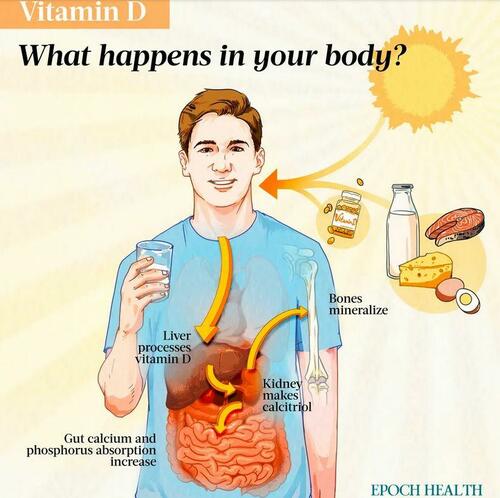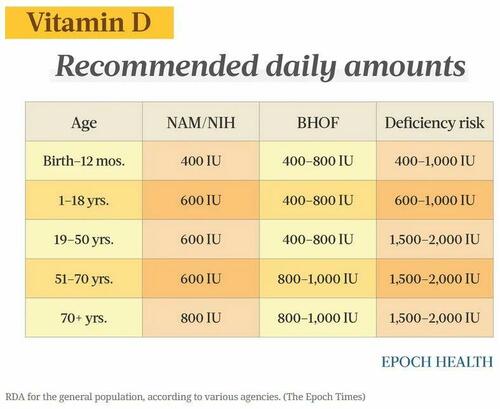


Authored by Mecura Wang and medically reviewed by Dr. Beverly Timerding via The Epoch Times,
Vitamin D, or the “sunshine vitamin,” is considered both a fat-soluble vitamin and a hormone because it can be obtained nutritionally, and our skin can synthesize it through sunlight exposure. It is integral to various bodily functions.
Primarily recognized for enhancing calcium absorption, vitamin D plays a role in maintaining bone and dental health, supporting the immune system, regulating cell growth, influencing mood, and preventing conditions such as multiple sclerosis.
Vitamin D deficiency is the most prevalent nutritional deficiency, affecting people of all ages globally. In the United States, nearly one-quarter of individuals have insufficient or deficient vitamin D blood levels, which can impact bone and overall health. Approximately 50 percent of children between ages 1 and 5 and 70 percent aged 6 to 11 experience vitamin D deficiency.
Vitamin D deficiency often arises due to insufficient sunlight exposure, inadequate dietary intake, and the skin’s inability to produce it. Also, natural foods typically do not provide enough vitamin D to prevent deficiency, making sunlight exposure a crucial factor.
Most people with vitamin D deficiency experience no symptoms. For others, common symptoms may include:
Other symptoms and signs of deficiency may include:
The complications of vitamin D deficiency are:
When you eat food or supplements containing vitamin D, your body undergoes two processes to activate it. First, in the liver, vitamin D is converted to calcidiol (25-hydroxyvitamin D). After that, the kidneys further transform it into calcitriol (1,25-dihydroxyvitamin D).
Calcitriol encourages the absorption of calcium and phosphorus in the small intestine. It also works with parathyroid hormone to enhance calcium transport, which is essential for maintaining proper calcium and phosphorus levels.
Vitamin D plays a crucial role in calcium absorption, essential for strong bones and teeth. It also supports muscle and nerve function, facilitating movement and communication within the body. In addition, vitamin D is vital for the immune system, as it helps defend against infections.
Other health benefits of vitamin D include:
In addition to the aforementioned bone-related and mental medical conditions, an adequate level of vitamin D can potentially prevent or lower the risk of certain diseases, including:
Vitamin D is not a single chemical but a group of compounds. The two major types of vitamin D are D2 and D3. Vitamin D2 and D3, collectively known as vitamin D, share nearly identical functions, yet neither becomes active until the body performs its transformative process.
Vitamin D2 comes from plants and fungi and is created when ergosterol is exposed to radiation. It is found in some plant-based foods and used in vitamin D supplements.
The body naturally produces a form of vitamin D from a widespread cholesterol variant called 7-dehydrocholesterol, mainly through exposure to sunlight. UVB energy from sunlight plays a crucial role in converting this precursor into vitamin D3. It is also found in some animal-based foods, such as fatty fish, egg yolks, and liver.
Vitamin D3 is commonly available in animal-based supplements. It is often considered more effective than D2, possibly due to its stronger connection with the vitamin D binding protein. This increased affinity may result in slower clearance of vitamin D3, leading to longer-lasting concentrations of 25(OH)D in the blood compared to D2.
The required daily amount of vitamin D varies based on an individual’s age. The recommended dietary allowance (RDA) for vitamin D is designed to meet the daily requirements for maintaining healthy bones and normal calcium metabolism in individuals with minimal sun exposure.
The recommended daily intake of vitamin D can vary among different organizations, such as the National Academy of Medicine (NAM) (formerly known as the Institute of Medicine, or IOM), which is part of the National Academies of Sciences, Engineering, and Medicine (NASEM), the Bone Health & Osteoporosis Foundation (BHOF) (formerly known as National Osteoporosis Foundation, or NOF), and the Endocrine Society.
The NAM RDA guideline below is also recommended by the National Institutes of Health (NIH). NAM considers these intake amounts adequate to achieve a vitamin D blood level of 50 nanomoles per liter (nmol/L), which they believe is sufficient for most people. In addition, according to the Endocrine Society, ensuring a consistent elevation of the blood level of 25(OH)D above 75 nmol/L may necessitate a daily intake of at least 1,000 IU of vitamin D.
The following table compares the recommended daily vitamin D amounts by the NAM and NIH, BHOF, and the Endocrine Society.
Vitamin D supplements are available in three types: vitamin D2, vitamin D3, and calcidiol. However, calcidiol is considered a medication, and it may be prescribed for individuals with health conditions causing malabsorption, such as cystic fibrosis, celiac disease, or liver disease, which impairs the synthesis of calcidiol from typical vitamin D supplements.
Vitamin D2 supplements are created by subjecting a plant sterol to ultraviolet energy, resulting in the production of vitamin D2. Vitamin D3 is usually generated through the irradiation of 7-dehydrocholesterol derived from lanolin obtained from sheep’s wool. Individuals who abstain from all animal-derived products can ask manufacturers about supplement sourcing and processing methods.
Ongoing debate surrounds the preference for vitamin D3 over D2 to increase blood levels. A meta-analysis suggests that D3 supplements tend to raise and maintain vitamin D levels more effectively than D2. Many experts favor vitamin D3 due to its natural production in the body and its presence in foods containing the vitamin.
One study involving 15,716 participants compared four treatment options for vitamin D deficiency, including vitamin D2 injection, vitamin D3 injection, a combination of vitamin D2 injection with a D2 tablet, and a combination of vitamin D3 injection with a D2 tablet. All treatments led to a significant increase in serum vitamin D within 12 weeks, with the vitamin D3 injection alone showing the highest increase. The findings suggest that using vitamin D3 in injectable form is the most effective option for restoring severe vitamin D deficiency, outperforming the injectable form of vitamin D2 and D2 tablets. However, the study did not address the effects of a vitamin D3 tablet/capsule, which is still generally better absorbed than oral vitamin D2.
Vitamin D2 and D3 supplements can be obtained over the counter or by prescription in the United States. They come in various strengths, including 400, 800, 1,000, 2,000, 5,000, 10,000, and 50,000 IU, with the latter requiring a prescription.
For adults, the general recommendation is a daily supplement containing 800 IU. Older individuals may still experience vitamin D deficiency at this intake level, so they might need to increase the dosage per their doctor’s instructions. In addition, all infants and children are advised to take a vitamin D supplement containing 400 IU starting shortly after birth.
As vitamin D is fat-soluble, it is most effectively absorbed when consumed with a meal or snack containing some fat.
Vitamin D supplements are also available in various forms, including:
Vitamin D is found naturally in a few foods, and most dietary intake in the United States comes from fortified foods supplemented with vitamin D.
Vitamin D3 is obtained from animal products, with oily fish, fish oils, eggs, and dairy serving as the best dietary sources. The amount of vitamin D in an animal’s tissues is influenced by its diet.
Most of the U.S. cow’s milk supply is fortified with approximately 120 IU of vitamin D3 per cup, and infant formula is fortified. However, foods derived from milk, such as cheese and ice cream, are typically not fortified. Rich sources of vitamin D3 include fatty fish such as trout, salmon, tuna, and mackerel, as well as fish liver oils. In addition to vitamin D3, animal-based foods often contain calcidiol, also known as 25(OH)D. Research suggests that calcidiol is around five times more effective than the parent vitamin in increasing serum 25(OH)D concentrations.
Examples of foods containing vitamin D3 include:
Unfortunately, we can obtain vitamin D from only diet, sun exposure, and supplementation. The belief that tanning beds can provide sufficient vitamin D is just a myth because tanning bed bulbs mainly emit UVA light, while vitamin D synthesis requires UVB light. Hypervitaminosis D (excessive vitamin D levels in the body) is a potential risk in a small proportion of tanning beds with UVB light. It’s not known if this is due to less heating of the skin in some facilities. Also, catching sunlight in a sunny office or while driving in a car won’t contribute to obtaining vitamin D, either, because window glass completely blocks UVB ultraviolet light.
Sunlight consists of two types of ultraviolet radiation: UVA and UVB. Although UVB is essential for the skin’s vitamin D synthesis, it can cause sunburn and contribute to cell damage linked to cancer. UVA also damages the skin and accelerates aging. To safeguard against sun damage and skin cancer, limit exposure during peak hours (10 a.m. to 2 p.m.), wear protective clothing such as a wide-brimmed hat and long-sleeved garments, and use sunscreen with SPF 30 or higher when too much exposure is unavoidable, ensuring it’s broad-spectrum for UVA and UVB protection.
Given the appropriate conditions, exposing the arms and legs to sunlight for 10 to 15 minutes a few times weekly can produce almost all the necessary vitamin D.
In addition to the aforementioned factors, elements affecting how much vitamin D your body makes include smog and other types of air pollution, season, and cloud cover. For instance, people living north of the 37-degree-latitude line, the imaginary line connecting Richmond, Virginia, and San Francisco, cannot obtain sufficient UVB exposure during winter to produce adequate vitamin D.
Blood 25(OH)D levels (combined vitamin D2 and D3) are a good indicator of vitamin D stores in the body and show a strong connection with symptoms and signs of deficiency. Blood tests measuring vitamin D, calcium, and phosphate levels can confirm a deficiency.
Certain disorders, hereditary conditions, and medications may impact vitamin D absorption or conversion of vitamin D to its active form, thus contributing to deficiency.
The following risk factors put someone at higher risk of deficiency:
To address vitamin D deficiency, increasing consumption of vitamin D-rich foods is often insufficient, prompting doctors to recommend supplements. The available forms of vitamin D supplements include vitamins D2 and D3 and calcidiol. The prescribed dosage varies based on factors such as severity, age, weight, and pregnancy status. The following table contains the suggested average daily dosages. The levels of 25-hydroxyvitamin D, or 25(OH)D, in the blood are used to measure vitamin D status.
Read the rest here...


